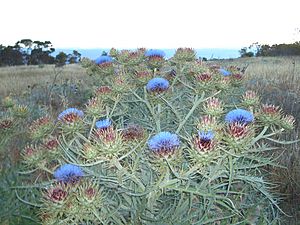O'Halloran Hill, South Australia facts for kids
Quick facts for kids O'Halloran HillAdelaide, South Australia |
|||||||||||||||
|---|---|---|---|---|---|---|---|---|---|---|---|---|---|---|---|
| Established | 1838 | ||||||||||||||
| Postcode(s) | 5158 | ||||||||||||||
| Location | 18 km (11 mi) from City-centre | ||||||||||||||
| LGA(s) |
|
||||||||||||||
| Region | Southern Adelaide | ||||||||||||||
| County | Adelaide | ||||||||||||||
| State electorate(s) | Mitchell, Davenport, Fisher | ||||||||||||||
| Federal Division(s) | Boothby, Kingston | ||||||||||||||
|
|||||||||||||||
O'Halloran Hill is a suburb located in the southern part of Adelaide, South Australia. It sits on hills that rise from the flat lands of Adelaide, about 18 kilometers from the city center. This area is divided between two local councils: the City of Marion and the City of Onkaparinga. It's surrounded by other suburbs like Happy Valley and Darlington. A big part of O'Halloran Hill used to be farms and vineyards. This area is now known as the Glenthorne Estate, which became the Glenthorne National Park–Ityamaiitpinna Yarta in 2018.
Contents
A Look Back: History of O'Halloran Hill
Before Europeans arrived, the land of O'Halloran Hill was part of Kaurna Yerta Parngkarra. This means the traditional country of the Kaurna people. Their land stretched from Cape Jervis in the south to Crystal Brook in the north.
The Kaurna People and Their Land
An area on the north side of the hill was called Wita-wattingga. This name means "in the midst of peppermint gums." At that time, the area was covered with low forests of peppermint gum trees. This forest stretched across the hills towards the main road.
The Kaurna people used a method called fire-stick farming. This involved carefully burning off dry plants in the foothills. This helped new plants grow and made it easier to hunt animals. However, when European settlers arrived, these fires sometimes damaged their farms and fences.
Naming the Hill and Roads
The suburb and the hill are named after Major Thomas O'Halloran. He was the first Police Commissioner of South Australia. His father was Major-General Sir Joseph O'Halloran. Majors Road, which runs through the suburb, is also named in his honor.
Changes to the Landscape
When the first Europeans came, the regular burning by the Kaurna people had changed the forests. Many original stringybark trees had been replaced by grasslands. Since the late 1960s, rules have helped native trees and bushes grow back. This has made the area look more natural again.
Parks and Special Places
O'Halloran Hill has some interesting natural and historical spots.
O'Halloran Hill Recreation Park
North of Majors Road is the O'Halloran Hill Recreation Park. This park covers about 293 hectares. It has walking trails that go through old bushland and past ruins of old farms. It's a great place to explore nature.
Glenthorne Estate and National Park
West of Main South Road is the Glenthorne Estate. This area covers about 200 hectares. It used to be farmland and vineyards. Major O'Halloran himself owned a farm and horse stud here called Lizard Lodge. He is buried in a cemetery on the western side of South Road, and his tomb is still there.
- Army Horse Stud: At the start of World War I, the Australian Army bought Glenthorne. They used it as a place to breed and train horses for the army.
- CSIRO Research: In 1947, the government took over the property. It became the Glenthorne CSIRO Research Station. Scientists worked there until 1998.
- University and Wine: Later, the property was given to the University of Adelaide. They used it for growing grapes and researching wine.
- National Park: In 2018, Glenthorne became the Glenthorne National Park–Ityamaiitpinna Yarta. It's now a protected area for everyone to enjoy.
Local Landmarks and Entertainment
O'Halloran Hill was once home to the 'Star-line' drive-in movie theater. It was special because you could watch movies and see the lights of Adelaide at the same time! It closed in 1984. Next to the drive-in was the Kingston TAFE College, which closed in 2014. This site is now used by the IQRA Islamic College.


